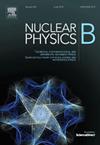Deflection angle around generic traversable wormhole solutions and energy conditions in extended teleparallel theory of gravity
IF 2.5
3区 物理与天体物理
Q2 PHYSICS, PARTICLES & FIELDS
引用次数: 0
Abstract
This study explores traversable wormhole solutions within the framework of gravity, a generalized teleparallel theory that extends gravity by incorporating the trace of the energy-momentum tensor . Adopting Weitzenbock geometry, we derive the field equations for a linear model and analyze Morris-Thorne wormhole geometries with two novel shape functions and a fractional redshift function. Violations of the null and strong energy conditions are illustrated, showing the presence of exotic matter near the wormhole throat, while the weak and dominant energy conditions are satisfied. Also, the effective potential for null and timelike geodesics reveals how particle trajectories depend on angular momentum, with deflection angle calculations demonstrating significant light bending near the throat. Numerical results show that increasing parameters in the shape functions enhance energy density and radial pressure violation, whereas larger redshift parameters reduce deflection angles at larger distances. Both shape function models support asymptotically flat and physically viable wormholes, with Model-I exhibiting stronger deflection effects.
广义可穿越虫洞解的偏转角及扩展遥平行引力理论中的能量条件
本研究探索了f(T,T)引力框架下的可穿越虫洞解,f(T,T)引力是一种广义遥平行理论,通过结合能量动量张量T的迹线扩展了f(T)引力。采用Weitzenbock几何,我们推导了线性f(T,T)模型的场方程,并分析了具有两个新颖形状函数和分数红移函数的Morris-Thorne虫洞几何。说明了零能和强能条件的违反,表明在虫洞喉部附近存在外来物质,而弱能和优势能条件是满足的。此外,零测地线和类时测地线的有效势揭示了粒子轨迹如何依赖于角动量,偏转角计算表明在喉部附近有明显的光弯曲。数值结果表明,形状函数参数的增大会增强能量密度和径向压力违逆,而红移参数的增大会减小较大距离处的偏转角。两种形状函数模型都支持渐近平坦和物理可行的虫孔,其中模型1表现出更强的偏转效应。
本文章由计算机程序翻译,如有差异,请以英文原文为准。
求助全文
约1分钟内获得全文
求助全文
来源期刊

Nuclear Physics B
物理-物理:粒子与场物理
CiteScore
5.50
自引率
7.10%
发文量
302
审稿时长
1 months
期刊介绍:
Nuclear Physics B focuses on the domain of high energy physics, quantum field theory, statistical systems, and mathematical physics, and includes four main sections: high energy physics - phenomenology, high energy physics - theory, high energy physics - experiment, and quantum field theory, statistical systems, and mathematical physics. The emphasis is on original research papers (Frontiers Articles or Full Length Articles), but Review Articles are also welcome.
 求助内容:
求助内容: 应助结果提醒方式:
应助结果提醒方式:


